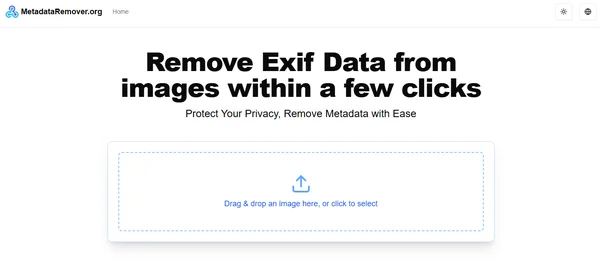What is Photo Metadata: Your Guide to Hidden Image Data
Every photo you take or share carries more than just visual information. Buried within its digital code are unseen details, a layer of information known as photo metadata. But are your photos revealing more than you think? This hidden data can expose personal details, location information, and even the specific device you used. Understanding what is photo metadata is the first step towards taking control of your digital privacy. This guide demystifies image metadata, explaining its importance for your privacy and security, and showing how easily you can manage it.
What Exactly is Photo Metadata? Understanding the Basics
Photo metadata refers to the descriptive information embedded within a digital image file. It's automatically generated by your camera or smartphone and can be added manually by photo editing software. Think of it as a digital fingerprint for your image, recording various details about its creation and content. While some metadata is harmless, other parts can be surprisingly revealing.

EXIF Data Explained: The Most Common Type
The most prevalent type of photo metadata is EXIF (Exchangeable Image File Format) data. Almost every digital camera and smartphone embeds EXIF data into JPEG and TIFF files. This data includes a wealth of technical information, such as:
- Camera make and model: Identifies the device used (e.g., iPhone 15 Pro, Canon EOS R5).
- Date and time: When the photo was taken, down to the second.
- Camera settings: ISO speed, aperture, shutter speed, focal length, flash status.
- GPS coordinates: Precise location data (geotags) where the photo was captured. This is particularly sensitive and often enabled by default on smartphones.
- Orientation: Whether the photo was taken in portrait or landscape mode.
EXIF data explained allows you to see the technical specifications of an image, which can be useful for photographers but a privacy concern for everyday users.
Beyond EXIF: IPTC, XMP, and Other Hidden Image Data
While EXIF is common, it's not the only type of hidden image data. Other metadata standards include:
- IPTC (International Press Telecommunications Council): Primarily used by photojournalists and news organizations. It includes descriptive information like captions, keywords, credits, copyright notices, and contact information.
- XMP (Extensible Metadata Platform): A more flexible and advanced metadata standard developed by Adobe. XMP data can be embedded directly into image files (like JPEGs, TIFFs, PNGs, and GIFs) and is easily editable. It often contains editing history, rating, and other organizational information.
- ICC Profiles: Color profiles that ensure consistent color representation across different devices.
Understanding these different types of image metadata highlights the vast amount of information that can be associated with your digital photos.
Why Your Photo's Metadata Matters for Privacy and Security
The presence of metadata in your photos isn't inherently malicious, but its unchecked sharing can pose significant privacy and security risks. What seems like harmless technical data can become a puzzle piece for those looking to uncover personal details about you. Protecting your photo privacy basics starts with managing this information.
What Sensitive Information Can Metadata Reveal?
Metadata can contain shockingly precise and personal details. If not removed, what sensitive information can metadata reveal includes:
- Your exact location: GPS coordinates from your smartphone can pinpoint your home, workplace, children's school, or vacation spot. This geotagging can lead to privacy breaches.
- Your daily routine: Timestamps can reveal when you're typically home, at work, or away on holiday, making you vulnerable to surveillance or even theft.
- Your device information: Knowing your camera or phone model might seem minor, but it can be used to identify you across different platforms or track your tech usage.
- Personal identifiers: Sometimes, software or device IDs can be embedded, which could potentially be linked back to you.
These hidden details can paint a surprisingly accurate picture of your life, making photo metadata removal a crucial step before sharing.

Real-World Risks of Unchecked Metadata Sharing
The implications of sharing photos with sensitive metadata extend beyond simple privacy concerns. These are not theoretical risks; they have real-world consequences:
- Stalking and harassment: Location data can be used to track movements or find out where someone lives or works.
- Theft: Posting vacation photos with geotags can alert criminals that your home is empty.
- Corporate espionage: Businesses might inadvertently share sensitive internal location data or details about proprietary equipment.
- Compromised security: In some cases, metadata has been used by malicious actors to gather intelligence for phishing attacks or social engineering.
- Identity theft: A mosaic of seemingly innocuous data points can be combined to build a detailed profile for malicious purposes.
Taking control of your image metadata is a proactive measure to safeguard your personal space and security online.
Who Needs to Remove Photo Metadata?
In reality, nearly everyone who shares digital photos online should consider removing metadata from them. Whether you're a casual social media user or a seasoned professional, the risks are real. Our metadata remover tool offers an easy solution for diverse needs.

For Everyday Social Sharers (Like Alex)
Consider Alex, who frequently posts on Instagram and Facebook, sharing moments from family vacations, dinners out, and daily life. Like many, Alex enjoys sharing but worries about privacy. This is where removing metadata from photos becomes essential. Without realizing it, Alex might be sharing the exact location of their home, their child's school, or their favorite coffee shop. A simple online tool to clear metadata ensures Alex can share memories without sharing sensitive personal information. It’s about protecting loved ones and maintaining privacy in a hyper-connected world.
For Professional Photographers & Businesses (Like Maria & David)
For Maria, a professional photographer, and David, a corporate compliance manager, metadata considerations are even more critical. Maria needs to protect her intellectual property and client privacy. When sending sample photos, she doesn't want clients or competitors seeing her expensive camera settings or where a private photoshoot took place. She needs to strip EXIF data reliably.
David, on the other hand, is concerned with legal compliance, such as GDPR. He must ensure that all images posted on the company website or marketing materials don't inadvertently reveal employee addresses, client locations, or confidential office layouts. An efficient metadata remover solution is crucial for maintaining corporate security and adhering to data privacy regulations. Both professionals benefit from an easy and secure way to delete image metadata before publication.
Empowering Your Privacy: Taking Control of Your Photo Data
Once you understand photo metadata, the next step is taking action. You have the power to control the information in your digital images. Removing metadata isn't just about deleting data; it's about actively protecting your privacy and security.

For a fast, free, and incredibly easy solution, consider using a reliable online metadata remover free. Our free online tool is designed with your privacy in mind. It allows you to remove metadata from photo files in seconds, ensuring your personal details stay private. Simply drag and drop your image, and our tool does the rest, delivering a clean image ready for sharing. Take control of your photo privacy basics today and feel more secure online. Try our free tool now!
Frequently Asked Questions About Photo Metadata
How do I remove metadata from my photos?
The easiest way to remove metadata from photos is by using a dedicated online metadata remover. Simply visit the website, upload your image (by dragging and dropping or clicking), and the tool will automatically process and remove all embedded metadata, allowing you to download a clean version. This method is quick, efficient, and requires no software installation. Clear metadata now.
Is using an online metadata remover safe?
When choosing an online metadata remover, safety should be your top priority. Reputable online metadata removers are designed with user privacy in mind. They emphasize that uploaded images are processed instantly and are never stored on their servers. This means your photos are not retained, ensuring your data remains private and secure. Always check the tool's privacy policy to confirm this commitment to data security.
Can all types of metadata be removed from an image?
Most common and sensitive types of image metadata, including EXIF, IPTC, and XMP data, can be effectively removed by a comprehensive metadata remover tool. This includes critical information like GPS coordinates, timestamps, camera models, and camera settings. While some less common, proprietary metadata might exist in niche formats, leading online tools typically cover the vast majority of data points that pose privacy risks for everyday users.
What is the difference between EXIF, IPTC, and XMP metadata?
EXIF data explained refers to technical information generated by cameras (e.g., shutter speed, ISO, GPS). IPTC (International Press Telecommunications Council) metadata focuses on descriptive and administrative data, often used by news organizations (e.g., captions, keywords, copyright). XMP (Extensible Metadata Platform) is a more flexible and robust standard, often used by photo editing software to store editing history, ratings, and other creative metadata. All three are forms of hidden image data that can reveal information about your photos.